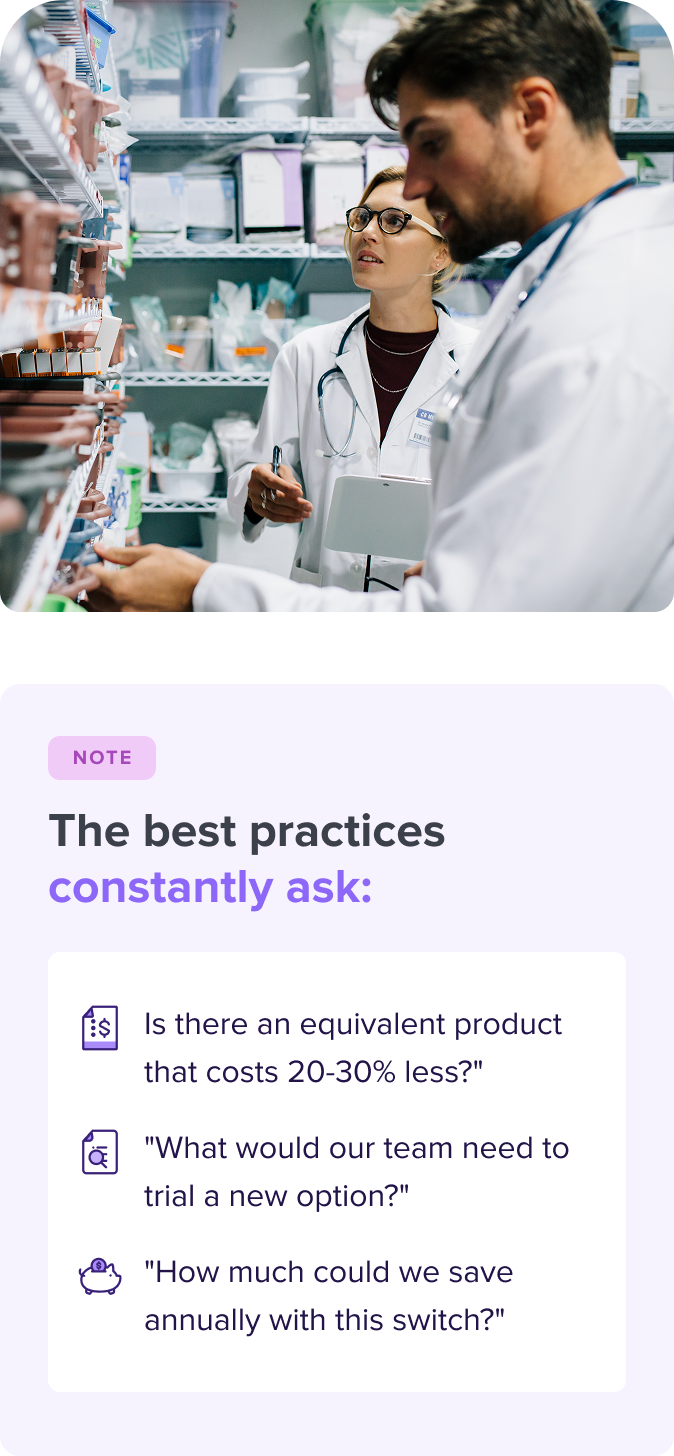Despite what manufacturers might say, the most expensive dental supplies aren't always the best.
At the same time, the cheapest options aren't always the smartest choice.
So what are the best products to keep in stock? Well, the answer isn't as simple as you might think.
Welcome to the nuanced world of strategic supply selection, where the smartest practices are moving beyond the tired "cheap vs. quality" debate to embrace a more sophisticated approach.

If your practice is spending more than 6.5% of revenue on supplies, you're overspending. That's the benchmark that separates efficient practices from those throwing money away on procurement.
The thing is, overspending rarely comes from buying "high-quality" clinical products. It comes from:
Changing this dynamic requires a strategic framework that treats different product categories…well, differently.
Not all supplies deserve the same decision-making process. Clinical products that touch patients require one approach. Everything else requires another.
This distinction forms the foundation of strategic supply selection.
When it comes to composites, bonding agents, and anything that directly impacts patient outcomes, the conversation changes completely. You're not just buying supplies—you're investing in clinical excellence.

Smart practices follow this protocol:
Remember: A root canal generates $800 in production, but you only keep about $200-250 after expenses. Every dollar you save in procurement equals $3-4 in production value. That $60 savings on composite? It's worth $180-240 in additional procedures you don't have to perform.
Here's where practices leave serious money on the table. Bibs, prophy paste, sterilization pouches, disposable cups—these items don't impact clinical outcomes, but they absolutely impact your bottom line.

The private label opportunity is massive:
Think of it like shopping at Costco. Their Kirkland batteries are made by Duracell, their organic produce meets the same standards as name brands, but you pay significantly less because you're not funding marketing budgets.
Once you understand the clinical vs. non-clinical distinction, you need a systematic approach to implement it.
Here's the framework that's helping practices nationwide optimize their supply decisions without compromising care quality.

Formulary management isn't a Showtime Rotisserie (you know, "set it and forget it.")
The best practices constantly ask:
Manual evaluation of hundreds of products across multiple suppliers is a recipe for wasted time and analysis paralysis. Even with the best intentions and frameworks, the complexity of modern dental procurement quickly overwhelms manual processes.
This is where procurement software like Method becomes an absolute necessity.
For instance, when you're placing an order, sophisticated procurement software instantly surfaces relevant alternatives.
Looking at that $180 composite? The system immediately shows you three clinically-equivalent options from other manufacturers, ranging from $145 to $165, along with private label alternatives starting at $125. It displays usage data showing you typically go through two syringes per week, suggesting optimal order quantities to avoid both stockouts and waste.

It doesn’t mean you have to switch suppliers. But it’s smart business to keep that door open.
The technology becomes even more powerful for formulary management across multiple locations.
Rather than hoping each office manager remembers which products are preferred, the system can highlight formulary items with visual cues, show compliance percentages, and even restrict off-formulary purchases when necessary. Then, when someone tries to order that expensive premium bib instead of the standardized option, the system can require approval justification or automatically suggest the preferred alternative.
The result is a procurement process that becomes more intelligent over time, learning from your purchasing patterns and continuously identifying optimization opportunities.
As with any plan, understanding is one thing but implementing it is another. Whether you're planning to incorporate a new technology solution or instead plan to start with a hands on approach, here's how to begin transforming your supply selection strategy immediately.

The practices thriving in today's market understand that every procurement decision is a business decision, and they have the tools and frameworks to make those decisions intelligently.
Stop choosing between "cheap" and "quality." Start choosing between "strategic" and "status quo."
Book time with our team to learn how you can reimagine your procurement strategy and go from guesswork to precision. Method has helped practices of all sizes optimize their supply selection while maintaining clinical excellence.









